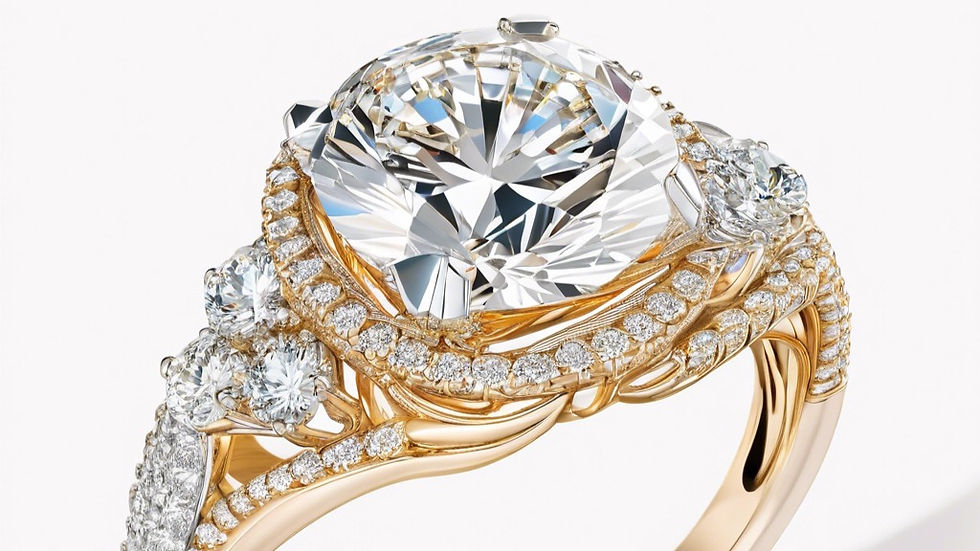Eco-Friendly Elegance: The Rise of Lab-Grown Diamonds
- Traditions
- Apr 24, 2024
- 3 min read

In a world increasingly driven by sustainability, lab-grown diamonds have emerged as a beacon of eco-friendly elegance, capturing the attention of environmentally conscious consumers and innovative jewelers alike. As we delve into the essence and evolution of lab-grown diamonds, we explore their creation, benefits, and the transformative impact they're having on the jewelry industry. One of the standout names in this revolution is Kiyvi Luxury, trading as "Traditions by Pooja Backliwal," which offers an exquisite array of these sustainable gems.
What Are Lab-Grown Diamonds?
Lab-grown diamonds are true diamonds produced in controlled environments using advanced technological processes that mimic the natural diamond growth conditions beneath the Earth's surface. The two primary methods used to create these diamonds are High Pressure-High Temperature (HPHT) and Chemical Vapor Deposition (CVD). Both methods result in diamonds that possess the same physical, chemical, and optical properties as mined diamonds.
Origin and Evolution
The concept of creating diamonds in a lab isn't new. It dates back to the 1950s but was primarily used for industrial applications. Over the decades, advancements in technology have allowed for the production of gem-quality diamonds, which today are virtually indistinguishable from their mined counterparts.
Differences and Benefits
Lab-grown diamonds offer several benefits over natural diamonds:
Sustainability: They require significantly fewer natural resources and generate fewer mineral wastes.
Ethical Assurance: Lab-grown diamonds avoid the often controversial mining processes associated with geopolitical tensions and ethical dilemmas.
Cost-Effectiveness: They typically cost 70-80% less than natural diamonds, making luxury more accessible.
The Industry's Changing Stance
Initially, major diamond companies were hesitant to embrace lab-grown diamonds, fearing they would undermine the value of natural diamonds. The definition of a diamond by leading industry bodies like the Gemological Institute of America (GIA) and the Federal Trade Commission (FTC) has historically centered around natural origin. However, as lab-grown diamonds gained popularity and acceptance, these organizations adjusted their definitions to include man-made options.
Big diamond companies have had to adapt to this shift. While some established players initially resisted, they now increasingly incorporate lab-grown diamonds into their portfolios, unable to compete with the cost and rapid production rates, especially by manufacturers in India, who are leading the charge in this space.
Cons
While lab-grown diamonds offer many advantages, they also present some challenges:
Perception: Some consumers still perceive lab-grown diamonds as 'less authentic' than mined diamonds.
Resale Value: Lab-grown diamonds typically have lower resale values than natural diamonds.

The Future of Lab-Grown Diamonds
The future looks bright for lab-grown diamonds. Industry forecasts predict significant growth, driven by technological advancements and increasing consumer demand for sustainable and ethical products. As the technology evolves, the quality and variety of lab-grown diamonds are expected to expand further, making them indistinguishable from the best-mined diamonds.
Traditions by Pooja Backliwal: A Leader in Lab-Grown Luxury
At the forefront of this sparkling revolution is Kiyvi Luxury, trading as "Traditions by Pooja Backliwal." This esteemed brand offers a wide variety of lab-grown diamonds, available in all shapes, colors, and sizes. Whether you're seeking a bespoke engagement ring or a stunning necklace, Traditions by Pooja Backliwal ensures that every piece not only embodies luxury and beauty but also stands as a testament to ethical and sustainable craftsmanship.
As the world pivots towards more eco-conscious choices, lab-grown diamonds from Traditions by Pooja Backliwal represent not just a purchase but an investment in a greener, more sustainable future.
